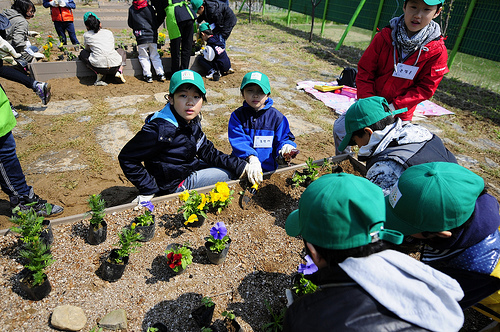
Junior Master Growers-Korea plant flowers in the People’s Garden at the Gwacheon National Science Museum.
You may remember when USDA Secretary Tom Vilsack announced last June that People’s Garden’s existed in all 50 states, two U.S. territories, and three foreign countries. Since then, People’s Gardens are cropping up at Foreign Agricultural Service (FAS) posts throughout the world. Read more »
More than 112,000 Rio Grande Valley moms, infants and children depend on the nutritional benefits provided by the USDA Food and Nutrition (FNS)’s Women, Infants and Children (WIC) program, according to participate rates in 2010.
The four counties that make up the Valley (Cameron, Hidalgo, Starr and Willacy) have done a good job of identifying nutritionally at-risk households through innovate outreach methods that have caught the attention of USDA Director of Faith-Based and Neighborhood Partnerships Max Finberg and USDA FNS Southwest Regional Administrator Bill Ludwig, who toured Hidalgo County’s main WIC clinic on April 11. Read more »
A new report titled Measuring Up: Synchronizing Biodiversity Measurement Systems for Markets and Other Incentive Programs was just released by the Willamette Partnership with funding and support from USDA’s Office of Environmental Markets (OEM). The report analyzes 25 existing biodiversity measurement systems to identify the elements necessary for a good system. It presents a standard process for developing measurement systems and offers options for improving the performance of biodiversity markets and conservation programs. The report’s findings are useful to those interested in measuring conservation effects and increasing the effectiveness of incentive programs. For example, the report examines how to balance precision and usability, and standardization and customization. Read more »
Recently, a USDA Rural Development project received one of the 2011 Governor’s Awards for Historic Preservation from the Michigan State Historic Preservation Office. The ceremony was held in the state Capitol rotunda and dozens of citizens and legislators from across the state turned out.
Michigan State Housing Development Authority Executive Director Gary Heidel opened the ceremony by noting the rich historic heritage of Michigan’s towns and cities and how the preservation of these sites is vital to keeping our state a place where people work, live and spend their leisure time. Read more »
This post is part of the Science Tuesday feature series on the USDA blog. Check back each week as we showcase stories and news from the USDA’s rich science and research portfolio.
U. S. Forest Service social scientist Lee Cerveny has carved out a special niche in the world of research. While her colleagues go into national forests and other protected areas to study things like trees and wildlife, she enters these natural environments to study humans – how they interact with and use a range of sites and resources.
Read more »

Lidgerwood kindergarten students planting one of seven Hackberry trees donated by USDA Natural Resources Conservation Service.
After a long, blizzard-filled winter, Earth Day was celebrated April 29 in Lidgerwood, North Dakota. USDA Rural Development delivered the latest in a number of loans and grants to help offset the cost of a $1.58 million project to provide safe drinking water to the city. Lidgerwood’s leaders first learned of arsenic in their water supply twenty-three years ago. After a number of other methods failed to solve the problem, the city eventually joined a regional rural water district. Rural Development North Dakota State Director, Jasper Schneider said the USDA is proud to partner with the city and other funding sources to make safe and reliable water a reality for its 700 citizens. Read more »


